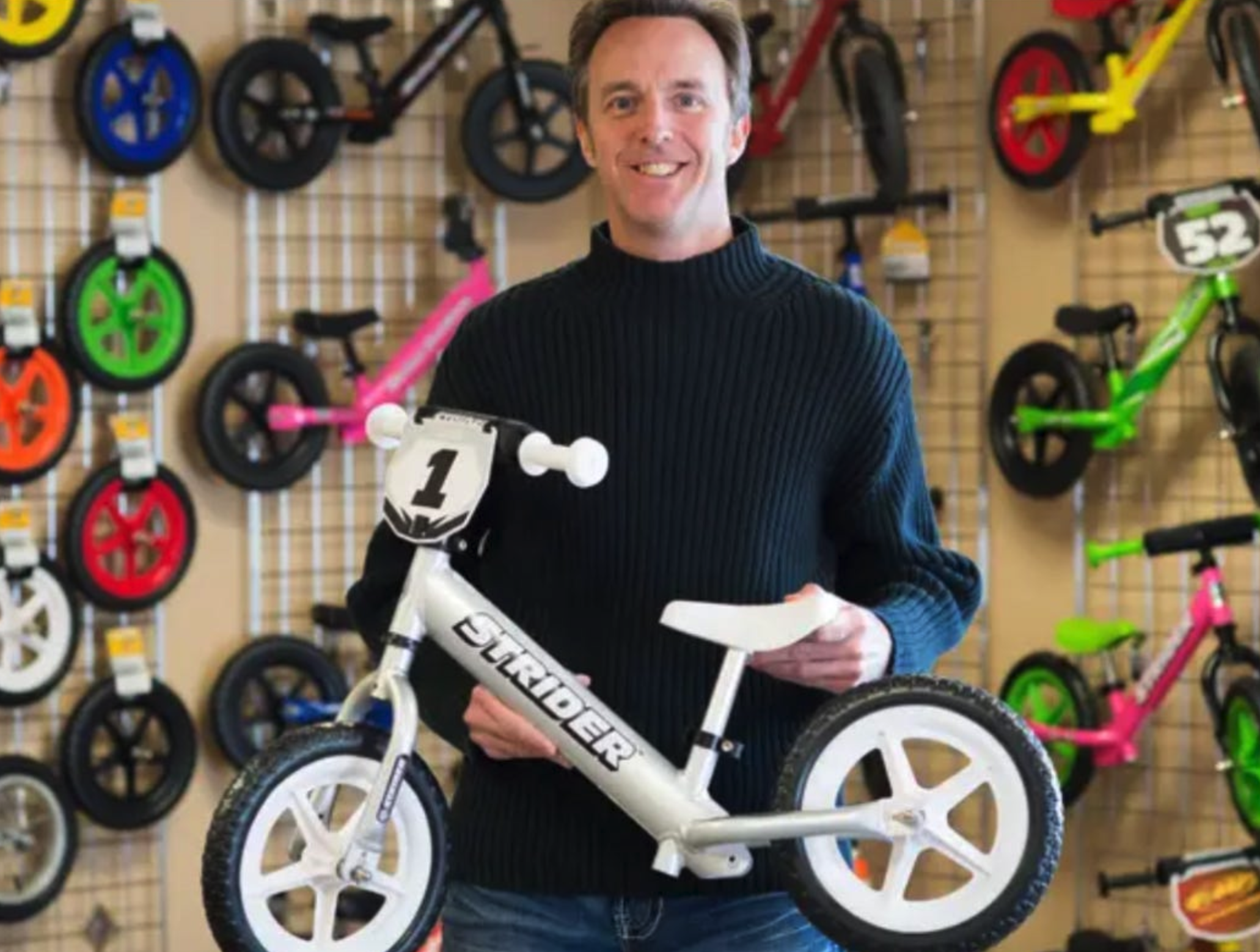Take Something Away
Guest post by Ted Lamade, Managing Director at The Carnegie Institution for Science
Ryan McFarland came from a long line of motorsports junkies given that his grandfather had been a race car engineer and his father ran a motorbike store. As a result, it shouldn’t come as a surprise that McFarland grew up riding dirt bikes and stockcars, or that he eventually went into the family business as well. It also shouldn’t come as a surprise that he was eager to pass on the McFarland “love of wheels” to his own son.
As any parent knows, getting a young child to ride a bike is a significant challenge. McFarland’s experience was no different. So, like many of us, he purchased an endless number of things to help his son get riding — toddler tricycles, trainer bikes, and even a training wheel equipped motorcycle.
Nothing worked. More importantly, each failed to teach his son the most important part of riding a bike — learning how to balance.
Think about it. While training wheels or a tricycle might stabilize a rider, neither allow a kid to equalize their weight on a bike.
The reason?
The extra wheels do all the balancing. They simply serve as a crutch.
So what did McFarland do?
He decided to engineer a very different type of bike, but rather than adding something to the bike, he chose to take something away — in this case the pedals.
The result was the Strider Bike, which enabled kids to focus exclusively on their balance and has since become one of the best-selling bikes of all-time, as well as a godsend for parents everywhere.

Within a few days, McFarland’s son was riding the Strider Bike. Within a couple weeks, he was riding a real bike. Within a few years, his company had sold millions of bikes. In short, McFarland had solved a significant challenge with a simple (and far less expensive) solution.
This story is far from the only case where the best solution came from using less of something rather than more. In fact, I have dealt with this dynamic personally over the past two years.
See, I grew up with eczema as a child, which I thankfully outgrew when I was about eight years old. Unfortunately, it reappeared in patches back in early 2021, so I went to see numerous doctors, dermatologists, and allergists. Each recommended a new cream, pill, and eventually a shot, which led to very mixed results. Finally it dawned on me to ask an allergist for a patch test, which is essentially a way to test to see if you are allergic to any specific chemicals that are commonly found in various soaps, shampoos, creams, and countless other products. I took the test and found out I was very allergic to two of the 150 things they tested for, one of which is prevalent in something called Aquaphor, which is a Vaseline-like ointment that we had been using on my both of my sons’ skin.
Care to guess when we had started using it?
You guessed it, early 2021. Precisely the same time that I started having a recurrence of my eczema.
So, what did we do?
We removed Aquaphor from daily use in our house, I stopped taking the various medications I was using, and my skin problems have slowly improved.
Whether it applies to training wheels or skin medication, this begs the question — why are we so inclined to add things rather than take them away when searching for solutions?
The answer is simple — human nature and incentives.
The fact is, people are biased towards solving problems through addition rather than subtraction.
The reason?
Because adding something makes you feel like you are advancing, while taking something away makes you feel like you are retreating. Couple this with the fact that most companies are incentivized to sell us endless “solutions”, and it should come as no surprise that the desire take something away is practically non-existent.
We see this dynamic across all parts of the economy, and society at large.
In healthcare, nearly every condition people face is addressed by adding something. Have a skin issue? Try this cream. Having trouble sleeping? Take this pill. Can’t lose weight? Take this new injectable called Ozempic (ironically a drug that aims to *take away *our appetites). Casey Means wrote extensively about this in her new book — Good Energy — that is now #1 on the Amazon charts. In short, she makes the case that instead of jumping immediately to medications that almost always have side effects, we should instead start by identifying what is causing the problem and trying to eliminate it. For example, if you have a skin issue, start by cutting out soaps with countless active ingredients. Can’t sleep? Cut back the amount of alcohol you drink and/or TV you watch before bed. Dealing with a stomach or weight issue? Try reducing the amount of processed food and sugar you eat.
In software, this concept of favoring less over more is known as the “Mythical Man Month” (or more simply, “Brooks’ Law”), which was discussed at length on a recent podcast Patrick O’Shaughnessy did with Bret Taylor (Co-Founder of Sierra, former Co-CEO of Salesforce, and a current board member at Open AI). Taylor pointed out that,
“If you want to make a software project take longer, add more people to it. This is based on the premise that when you are developing a complex system, smaller teams who complete each others’ sentences, each own part of the system, truly understand it, and work in unison create a magical, yet fragile, dynamic. This is the case because adding more people means more bureaucracy, which risks disempowering some of your best people and slowing things down. Just look at Healthcare.gov as a perfect example.”
Retail is another obvious example. Look no further than Starbucks’ recent troubles. One of the main culprits? The decision to add countless options to their mobile app. In short, by designing its app to enable customers to hyper-customize their favorite drinks (according to one report there are over 170,000 ways to customize a Starbucks order), it led to orders like the one below:

Instead of increasing revenues and customer retention, this hyper customization led to poor customer service, employee turnover, longer wait times, and often incorrect drink orders. Eventually, it even led to Starbucks firing its CEO and replacing him with Brian Niccol, who made a name for himself running a company that has nearly perfected the concept of “taking things away” — Chipotle.
In short, by having far fewer options and ingredients, Chipotle created a juggernaut in the fast casual category by maximizing efficiency, throughput, and quality, which is a very different business model than a company like McDonalds, which has an endless number of options on its menu and is constantly adding new ones.
As a result, last year Chipotle’s restaurants collectively generated more than $10 billion in annual revenues and close to $2 billion in annual operating profits (up from $900 million and $250 million respectively fifteen years ago). This model has resulted in a stock that has compounded at more than 25% annually over the past decade-and-a-half, which means that $1,000 invested in 2009 would be worth more than $40,000 today.
Unfortunately, too many investors manage their portfolios like McDonalds or Starbucks instead of Chipotle. In an attempt to improve or upgrade them, they almost always look to layer on new investments, commitments, asset classes, and securities, often shooting well past an appropriate level of complexity:
Worried about a market crash? Layer on expensive hedges.
Concerned about volatility? Buy complicated options.
Want to generate higher returns in a low interest rate environment? Add leverage.
Trying to keep up with other investors? Chase a hot buyout or venture capital fund.
The trouble is that when they do this, the more vulnerable their portfolios become. It causes them to lose track of what they own, reduces their portfolio’s liquidity and transparency, and forces them to pay higher fees in the process. It also often leads to investors being forced to make decisions they swore they never would, typically at the worst possible moments.
We saw this first hand in the lead up to, and during, the Covid crazed market of 2020-2021. “One man band” venture capitalists were able to raise money with ease, firms like Tiger Global sprayed money in every direction with little diligence, term sheets from unknown investors landed on general partners’ desks, “extension funds” were waved into portfolios without even the slightest objection from limited partners, leverage was easy to come by, and investors happily traded daily liquidity for decade liquidity. Yet this is just the tip of the iceberg, as there were countless other examples of investments and structures being added to portfolios in pursuit of higher returns.
However, in 2022 and 2023, this dynamic changed materially as “one man VCs” started to disappear, the Tigers of the world were humbled and retrenched, those blind term sheets stopped coming, extension funds were tabled, limited partners starting guarding liquidity with their lives, and investors more broadly started pulling in the reins as they attempted to determine what lay ahead.
So, experiences like this beg a few questions:
Is increased complexity the path to better performance, or would investors be better off if they simply removed a few things?
Should investors hold one hundred 1% positions in their portfolio (i.e., be overly diversified), or should they concentrate their bets in their highest conviction positions, watch them closely, and add to them when they get dislocated?
Should investors deploy capital at a torrid pace during bull markets, or would they benefit from slowing down a bit?
The answer in each case is very likely an emphatic “yes” to the latter.
In fact, this probably goes for most things in life.
Think about it this way. What would happen if you reduced the number of things you focus on in your daily life by 20%? How about 30%?? Say 50%???
What are the chances you wouldn’t miss the things you cut out?
Would you possibly become more focused on the things you decided to keep?
Would you end up being a happier person? A better colleague? Parent? Spouse?
My guess is the answer would be a “yes” across the board here too.
But you might say, my life or portfolio is already SO complicated, how can I possibly uncomplicate it?
My response?
Just because things have gotten complicated doesn’t mean you can’t reverse it. Afterall, if Elon Musk can do it with his Raptor rocket engines, you can too.

In this day and age the case can be made that we live in an era of too much. Too much information, too much stuff, too many choices, and too many distractions. As a result, there is a good chance that the path to happier lives, and yes, better portfolio performance, might start by taking things away.